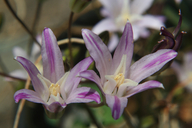Taxon Report
Brodiaea rosea (Greene) Baker ssp. roseaIndian Valley brodiaea |
 © 2014 Robert E. Preston, Ph.D. |
Taxon Summary
Brodiaea rosea ssp. rosea, commonly known as Indian Valley brodiaea, is a perennial bulbiferous herb in the Themidaceae that is found only in California. It occurs within Chaparral, Cismontane woodland, Closed-cone coniferous forest, and Valley and foothill grassland, growing at elevations from 335 to 1450 meters. Brodiaea rosea ssp. rosea is ranked 3.1, Plants About Which We Need More Information, A Review List; Seriously threatened in California.Classification
|
Scientific Name: |
Brodiaea rosea (Greene) Baker ssp. rosea |
|
Common Name: |
Indian Valley brodiaea |
| Family: | Themidaceae |
| Element Code: | PMLIL0C0K3 |
| USDA Plants Symbol: | |
|
Synonyms/Other Names: |
|
Ecology and Life History
| Lifeform: | perennial bulbiferous herb |
| Blooming Period: May-Jun | May-Jun |
| Elevation: | 335-1450 (1100-4755) |
| General Habitats: | Chaparral, Cismontane woodland, Closed-cone coniferous forest, Valley and foothill grassland |
| Microhabitat: | Serpentine |
| Microhabitat Details: |
Conservation Status
| CA Rare Plant Rank: | 3.1 |
| Global Rank: | G2Q |
|
State Rank: |
S2 |
| State List: | CE |
| Fed List: | None |
| Other Status: | BLM_S; USFS_S |
|
CRPR Changes: |
|
Occurrence Data from the CNDDB
| Total Occurrences: | 21 |
| Element Occurrence Ranks: | |
| Excellent (A) | 8 |
| Good (B) | 4 |
| Fair (C) | 4 |
| Poor (D) | 0 |
| None (X) | 1 |
| Unknown (U) | 4 |
| California Endemic: True | |
| California Counties and Islands: Name (Code) | |
| Colusa (COL), Glenn (GLE), Lake (LAK), Shasta (SHA), Tehama (TEH), Trinity (TRI) | |
| Quads: Name (Quad Code) | |
| Chicken Hawk Hill (4112214), Gilmore Peak (3912235), Hough Springs (3912225), Leesville (3912224), Riley Ridge (3912286), Stonyford (3912245), Trinity Center (4012286), Trinity Dam (4012277), Wilbur Springs (3912214) | |
Threat List Data from the CNDDB
| Threat List Total: | 8 | |
| EOs with Threat Listed: | Total EOs | % of EOs |
| 10 | 48 % | |
| Other | 6 | 28% |
| ORV activity | 4 | 19% |
| Vandalism/dumping/litter | 3 | 14% |
| Non-native plant impacts | 2 | 9% |
| Dam/Inundation | 2 | 9% |
| Grazing | 1 | 4% |
| Mining | 1 | 4% |
| Surface water diversion | 1 | 4% |
Notes
| Recircumscribed as B. rosea ssp. rosea; principal components, cluster, and discriminant analyses clearly demonstrate the existence of two morphologically diagnostic taxonomic groups within B. rosea, but do not support recognition of serpentine endemic and non-serpentine taxa. Violet flowered populations with strongly inrolled staminodes, previously assigned to B. coronaria, are morphologically more similar to B. rosea, thereby greatly increasing its distribution to volcanic, non-serpentine, occurrences in northeastern CA, and north to British Columbia. Treated here as a serpentine ecotype from Interior North Coast and southeastern Klamath Ranges; further genetic and molecular data are needed to assess whether serpentine populations of B. rosea represent a morphologically-cryptic ecotype that is worthy of taxonomic status. |
|
Threats: |
| Threatened by vehicles, dumping, and horticultural collecting. |
|
Taxonomy: |
Selected References
| Proposed Change from California Rare Plant Rank 1B.1, G2 / S2 to 3.1, G2Q / S2 |
| Bulletin of the California Academy of Sciences 2:137 (1886) |
| American Midland Naturalist 22:560-561 (1939) |
| Brodiaea rosea profile for potential Species of Conservation Concern evaluation (2018) |
Citation
California Native Plant Society, Rare Plant Program. 2025. Rare Plant Inventory (online edition, v9.5.1). Website https://www.rareplants.cnps.org [accessed 27 December 2025].